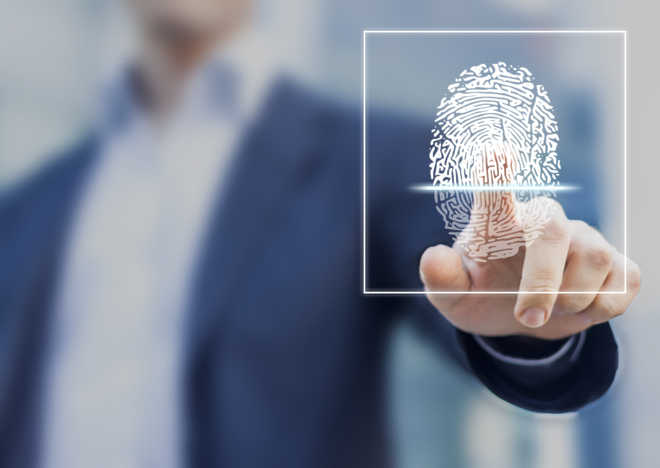Dr Vikas Sharma
Due to their uniqueness and individualistic characteristics, fingerprints are considered the most powerful and widely used biometric identity proof. In the era of Digital India, biometrics have become an integral part of our lives.
Fingerprints are unique to every individual and no two persons have similar fingerprints. These appear in the intrauterine life and these do not change during the life time of an individual. High degree of sensitivity and specificity thus, makes our prints the most popular method of identification in modern times.
Today, fingerprint identification is used as identity proof by most government organisations and even private ones and also by law enforcement agencies, right from Aadhaar card to financial transactions, aviation, immigration and security checks for entry into another country, office access, operating bank accounts, safety lockers, computers and mobile phone access and so on.
In such a world, loss of fingerprints can have serious implications and trigger an identity crisis. There are several skin conditions that can lead to loss of fingerprints.
Palmar eczema is one such disorder. Fingertip eczema is a very dry, chronic eczema of the palmar surface of the fingertips. One finger or several fingers may be affected. The skin first becomes moist and then becomes dry, cracked, and scaly. The skin peels from the fingertips distally, exposing a very dry, red, cracked, fissured, tender, or painful surface without skin lines, leading to loss of fingerprints.
Palmar psoriasis: Psoriasis of the palms and fingertips is characterised by red plaque with thick brown scales. The lamellar scales are more adherent than those on other parts of the body and their removal tends to reveal the reddish inflammatory base. It may cause cracking and painful fissures and bleeding. This disorder leads to changes in the junction of epidermal and dermal layers of the skin thus influencing the fingerprint pattern recognition.
Cheiropompholyx (dishidrosis) is a distinctive reaction pattern presenting as symmetric vesicular hand dermatitis. It is one of the most common skin disorders. Itching precedes the appearance of tiny water-filled vesicles on the palms and sides of the fingers which are relatively deep seated. The vesicles slowly resolve and are replaced by erythematous scaly patches. Chronic eczematous changes with erythema, scaling and lichenification follow affecting the fingerprints.
These skin pathologies can cause disruptions to papillary lines, altering the depth and steepness of the ridges and valleys of the tips. This can affect analysis by modern-day biometric pattern recognition systems.
An early diagnosis and specific treatment can prevent skin lines to be affected and destroyed completely.
If the disease has attacked and destroyed the structure of papillary lines in the epidermis and underlying dermis (two layers of the skin), the papillary lines will not grow in the same form as before (if at all), and therefore such users will have to be excluded from the use of fingerprint recognition systems in their future life, even though their fingers do not have any symptoms of the skin disease anymore.
Other disorders which can result in loss of fingerprints include irritant contact dermatitis, atopic dermatitis and mechanical abrasion.
It is clear that the colour of the skin and the structure of papillary lines on the fingertip are severely influenced by some skin diseases. If only the colour has changed, some of optical fingerprint scanners might be influenced, and so this change is not that crucial.
However, the change in skin structure is significant, because if papillary lines are damaged, it is impossible to find the minutiae and therefore to recognise the person. An early and specific treatment of these skin conditions is, therefore, of paramount importance to save the fingerprints.
Infectious skin disorders
Leprosy: It can lead to loss of tissue of fingertips.
Chronic fungal infection of hands: Tinea manuum is a fungal infection of the hands. Tinea is also called ringworm, and manuum refers to it being on the hands. The chronic hyperkeratotic type can lead to loss of fingerprints though recovery is possible after treatment with antifungal medicines.
Inflammatory skin disorders
Systemic sclerosis: Systemic sclerosis is a chronic autoimmune disease characterised by sclerosis of the skin and other organs. Emergence of acrosclerosis is decisive for fingerprinting. Initially the skin is infused with edema mainly affecting hands. With the progressive edema stiff skin appears and necrosis of fingers may form.
The disease leads to sclerodactyly with contractures of the fingers. Typical “rat bite” necroses and ulcerations of fingertips may develop, healing with pitted scars leading to loss of fingerprints.
Raynaud phenomenon: Raynaud’s phenomenon represents an episodic vasoconstriction of the digital arteries that is precipitated by cold and stress. Persistent vasospasm of medium-sized arterioles can sometimes lead to gangrene of the terminal digits.
Drug eruptions: Loss of fingerprints is also associated with hand–foot syndrome (chemotherapy-induced acral erythema), a common adverse effect of various chemotherapeutic agents.
People with a rare disease known as adermatoglyphia do not have fingerprints from birth.
—The writer is a dermatologist, National Skin Hospital, Panchkula
Unlock Exclusive Insights with The Tribune Premium
Take your experience further with Premium access.
Thought-provoking Opinions, Expert Analysis, In-depth Insights and other Member Only Benefits
Already a Member? Sign In Now










